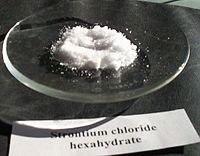This is an old revision of this page, as edited by Walkerma (talk | contribs) at 03:21, 16 December 2005 (+de). The present address (URL) is a permanent link to this revision, which may differ significantly from the current revision.
Revision as of 03:21, 16 December 2005 by Walkerma (talk | contribs) (+de)(diff) ← Previous revision | Latest revision (diff) | Newer revision → (diff) Strontium chloride hexahydrate | |
| IUPAC name Strontium chloride | |
| General | |
|---|---|
| Molecular formula | SrCl2 |
| Molecular weight | 158.53 amu (anhydrous)
266.62 amu (hexahydrate) |
| Appearance | White crystalline solid |
| CAS number | (anhydrous)
(hexahydrate) |
| MSDS | Strontium chloride MSDS |
| Other names | |
| |
| Bulk properties | |
| Density | 3.052 g/cm (anhydrous, monoclinic form) |
| Solubility | water: 53.8 g/100 cm (20 °C)
ethanol: very slightly soluble acetone: very slightly soluble |
| Melting point | 874 °C (1147 K) |
| Boiling point | 1250 °C (1520 K) |
| Hazards: | Irritant |
| Structure | |
| Coordination geometry | octahedral (six-coordinate) |
| Crystal structure | Deformed TiO2 |
| Hydrates | dihydrate (rare)
hexahydrate |
| Related compounds | |
| strontium fluoride | calcium chloride |
Strontium chloride (SrCl2) is a salt of strontium and chlorine. It is ionic and water-soluble. It is less toxic than barium chloride, though more toxic than calcium chloride. It emits a bright red colour when heated in a flame.
Chemical Properties
Strontium chloride is a typical ionic metal salt, and it can be used as a source of other strontium compounds such as strontium chromate:
SrCl2(aq) + Na2CrO4(aq) → SrCrO4(s) + 2 NaCl(aq)
SrCl2 always acts as a simple salt, and it is completely neutral in solution.
Preparation
Strontium chloride can be prepared from strontium hydroxide or strontium carbonate reacting with hydrochloric acid:
Sr(OH)2(aq) + 2 HCl(aq) → SrCl2(aq) + 2 H2O(aq)
It can also be prepared by the union of the elements, strontium and chlorine.
Uses
There are no major uses for strontium chloride, though it can be used to prepare less common compounds of strontium. Like barium chloride it can be used to test for sulfate ion, though not at such low concentration, since strontium sulfate is more soluble than barium sulfate.
SrCl2(aq) + SO4(aq) → SrSO4(s) + 2 Cl(aq)
Strontium chloride is occasionally used as a flame coloring agent in pyrotechnics.
Precautions
Although much less toxic than barium chloride, strontium chloride should still be handled with care.
Suppliers/Manufacturers
References
- N. N. Greenwood, A. Earnshaw, Chemistry of the Elements, Pergamon Press, Oxford, UK, 1984
- Handbook of Chemistry and Physics, 71st edition, CRC Press, Ann Arbor, Michigan, 1990
- The Merck Index, 7th edition, Merck & Co., Rahway, New Jersey, 1960